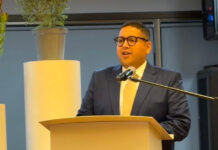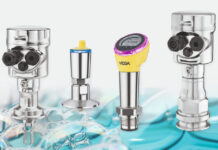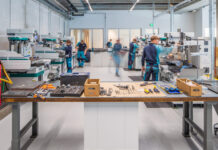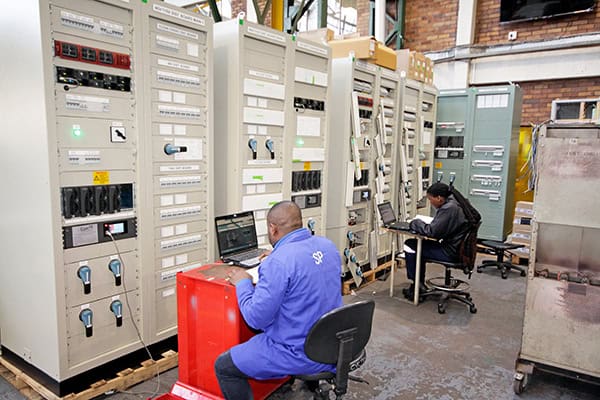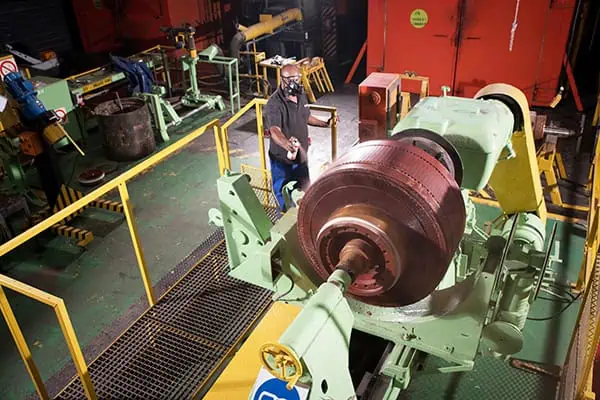Under the control of Transnet, South Africa has the most extensive rail network and infrastructure on the African continent, with 22,000 kilometres of rail track, 585 train stations, a fleet of 4,735 coaches and an overall staff complement of just over 18,000. Transnet, with a rich history dating back to the late 19th century, is vital in connecting cities, towns, and rural areas, facilitating the movement of goods and people across the country and playing an expansive role in the economic health of South Africa.
The South African Government’s plan to spend R900 billion by 2027 infrastructure. But spending on rail infrastructure has been beset by regulatory and organisational challenges, including cabling, rail and station infrastructure theft. Since 2017, Transnet has faced operational problems, mainly in the critical rail and port businesses, resulting from underinvestment in infrastructure and equipment. This has negatively impacted the country’s leading transport and logistics firms, inevitably created problems regarding the exportation of commodities, and has had a negative trickle-down effect on the manufacturing and services sectors.
Inefficiencies in rail freight have resulted in delays, increased costs and reduced competitiveness for South African producers and exporters, ultimately affecting the country’s productivity and economic growth. Mervyn Naidoo, CEO, ACTOM said, “Freight rail is much lower than it used to be, negatively affecting the economy and adding a domino effect in job losses, manufacturing, and import and export funding”.
Loaded trucks significantly damage national road infrastructure, and by improving efficiencies, Transnet will activate both upstream and downstream opportunities. Increased rail volumes will also lead to decreased road congestion, reduced road maintenance and fewer accidents.
“Mining companies that export commodities like coal, iron ore, and manganese are key drivers of the economy and will significantly benefit from improved efficiencies within the South African Railway Services. Increased tonnages in freight volumes will lead to increased revenues for both the mining companies and Transnet and contribute to accelerated GDP growth, more employment opportunities, alleviate poverty, reduce unemployment and aid in reducing the social burden on the state”, Naidoo added.
Transporting coal to port by rail costs about R230 a tonne, but when trucked via road, these costs can quickly increase almost threefold to about R750 a tonne. Expanding the railway infrastructure can help South Africa grow its current 70 million tonnes of coal exports annually. Road freight is unsustainable for the transport of bulk export commodities such as coal and iron ore.
Transnet’s railway business recovery plan is a comprehensive strategy to restore South Africa’s rail network’s operational performance and freight volumes. In July 2024, the African Development Bank (AfDB) approved an R18.85 billion corporate loan, facilitating the first phase of Transnet’s R152.8 billion five-year capital investment plan. “Transnet’s funding from AfDB will enable them to expand and resuscitate existing infrastructure”, Naidoo said.
The recovery plan addresses operational inefficiencies, particularly in the rail and port sectors, and restoring the rail network to its former glory. This will be achieved through infrastructure upgrades, equipment replacements, and process improvements. The plan also prioritises energy efficiency and railway reforms to reduce costs and enhance the overall sustainability of the rail network.
Key components of the plan include:
- Infrastructure upgrades to increase capacity and reduce congestion
- Equipment replacements to improve reliability and efficiency
- Process improvements to enhance customer service and reduce transit times
- Energy efficiency initiatives to reduce costs and environmental impact
- Railway reforms to promote competition and investment
The successful implementation of Transnet’s railway business recovery plan is expected to significantly impact the South African economy, enhancing national logistics capabilities, driving sustainable economic growth, and creating jobs. Transnet aims to regain market share, improve customer satisfaction, and position itself as a competitive and efficient logistics player in the region.
Positive impacts:
- Improved efficiency: Upgrades to ports and rail infrastructure will increase cargo handling capacity, reduce congestion and dwell times, and make local businesses more competitive.
- Job creation: The recovery plan will lead to new job opportunities in construction, maintenance, and operations.
- Economic growth: Enhanced infrastructure will attract investments, stimulate trade, and boost economic growth.
- Increased competitiveness: Modernised infrastructure will enable local businesses to compete more effectively with international companies.
ACTOM offers a one-stop railway solution
ACTOM, a South African electrical engineering and manufacturing company, will benefit from Transnet’s recovery plan and the African Development Bank’s (AfDB) funding to Transnet in several ways:
Increased demand for products: Transnet’s upgrades and expansion plans will require electrical infrastructure, such as transformers, switchgear, railway signalling equipment and cabling, which ACTOM manufactures and supplies. Due to a general lack of infrastructure maintenance, Transnet’s Freight Rail line inefficiencies have led to a severe maintenance backlog with their 3000 Volt DC substations and 25,000- and 50,000 Volt AC substations. ACTOM is perfectly positioned to capitalise on a comprehensive refurbishment program of old transformers or build new ones to Transnet’s specifications. “Regarding capacity expansion, equipment replacement poses many opportunities for ACTOM, such as transformer equipment, switchgear, high voltage equipment, and associated equipment that goes into these substations. So, the substation is just one infrastructure element, but the crucial component is the signalling system regulating traffic flow. ACTOM has supplied signalling systems to Transnet and Metrorail/PRASA for many years,” said Naidoo.
Supply chain optimisation: With AfDB funding and the South African government focussing on localisation and development in South Africa, Transnet will prioritise local procurement, which will favour ACTOM, with their one-stop solution, as they have a rich history of servicing and completely overhauling South African railway locomotives. Naidoo said: “Locomotives are quite robust but require a major overhaul every 10 – 12 years. We can completely overhaul the 40 – 50-year-old locomotives to the point where they will be good again for another decade”.
Diesel-electric locomotives move goods safely and efficiently by generating their own electricity to power the traction motors and are not reliant on an electrical power supply. Diesel locos are thus more versatile than electric fleets as they do not suffer from operational disruptions due to power outages or overhead line copper theft. Reid & Mitchell, one of ACTOM’s 34 operating units across Sub-Saharan Africa, offers manufacturing, refurbishing and upgrade options on a range of electrical rotating machines and auxiliary controls for these prime movers of our economy.
“Our Traction division is fully equipped with capabilities to build, overhaul, upgrade and maintain diesel-electric locomotive components (AC and DC). Our advanced refurbishment processes can significantly extend the life of the electrical rotating components at a fraction of the cost of purchasing new units,” said Mike Shaw, Divisional CEO, Reid & Mitchell.
Partnership opportunities: ACTOM Transport, a business unit within the Engineering Projects and Contracts division, offers a comprehensive turnkey capability in railway automation, signalling and control systems, and traction equipment and components. Its partnership with international signalling equipment manufacturers offers a complete turnkey solution to the railway sector. It provides specialised depot assembly and test equipment such as wheel presses, bogie testing presses, various test equipment, and power supplies through its representation in Southern Africa of BBM and IRMIE Impianti of Italy, which ensures the latest adaptable technology offerings to support Transnet’s sustainability goals. “With our international partners, we can custom make any product, dependant on the client’s standards, and have it installed within the required lead times”, said Leonard de Villiers, General Manager, ACTOM Transport.
Shaw agrees, as Reid & Mitchell, too, has a long-standing partnership with various original equipment manufacturers (OEMs), specialising in repairing, refurbishing, and rebuilding locomotive rotating components.
Job creation and skills development: As ACTOM ramps production to meet increased demand, they create new job opportunities and develop skills in the local workforce. The LHM School of Engineering, a SETA-accredited training academy, has been preparing for the increase in traction transformer manufacturing for some time. “There has been an uptake in transformer manufacturing in the last few years, and we have had a considerable intake of students to train them as welders, armature winders, fitters & turners and electricians,” said David Sullivan, Divisional CEO, LH Marthinusen.
With the increase in production, Sullivan hopes to offer these apprentices permanent positions within the ACTOM group. “The good news is that, hopefully, there will be permanent positions for these apprentices when they finish their qualification, and the first candidates from the increased intake will finish their four-year qualification at the end of next year,” Sullivan added.
Diversification opportunities: ACTOM has the facilities to diversify its product offerings to meet new infrastructure needs. Many of ACTOM’s divisions have the capabilities to design bespoke equipment needed to meet the client’s specific standards. “Our client’s standards are usually well-written, and we ensure uniformity in the manufacturing of any of their products”, said Sullivan.
Shaw added: “We have the Reid & Mitchell Centre of Excellence, which becomes operational when we have big projects. We sport a team of experts that works like a well-oiled machine to finish the job within deadlines”.
According to Frans Weygertze, Project/Business Development Manager, ACTOM Transport Equipment & Projects (TEP) sees a broader product offering as a significant opportunity for collaboration with customers and suppliers in setting up various partnership agreements to enhance its portfolio in the future.
Improved competitiveness: While the Transnet loan will contribute to the broader South African economy, it will also aid their energy efficiency efforts, assist with infrastructure project preparation initiatives, and improve completeness.
ACTOM Static Power, a business within the Smart Technologies portfolio, specialises in designing and manufacturing AC and DC standby equipment for the industrial, telecoms, rail, and renewable energy markets. This includes thyristor-type chargers (Micro Process Controlled option), industrial batteries, power supplies, industrial UPS, furnace control panels, AC/DC distribution boards, and battery-tripping units.
All their systems are designed and engineered to suit their purpose for local and export markets. Static Power’s success is a testimony to the quality of its products and services, and it has embarked on turnkey solutions for renewable energy and battery energy storage. Richard von Moltke, General Manager, Static Power, states, “ACTOM Static Power is almost unique. What gives us an edge is that we adapt to each site, customer, and project because no two projects are the same. Supplying a standard product does not work in the industry. Even though it’s all doing the same thing, each site is different and integrates into other components.”
Weygertze added, “Price, availability, and quality will be of the essence, and we are positive that we can market ourselves using local content and a social development framework in a tough microeconomic environment.”
ACTOM, with its local expertise and manufacturing, extensive range of standard and tailor-made products and services, international partnerships, and partner networks, offers a competitive complete solution to Transnet’s Railway and Port infrastructure needs. As such, it is perfectly positioned to capitalise on any opportunities that may and will be created through Transnet’s recapitalisation initiative.

